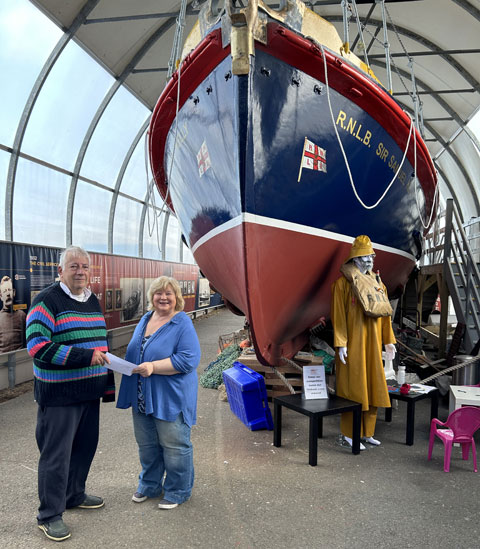On the 24th August 2024 members of Bangor Historical Society met on the pier at Donaghadee for their summer outing. Robert Neill led a walk around the harbour area of the town. He explained about the various owners of the town from Hugh Montgomery at the beginning of the seventeenth century to the Delacherois and Day families in the twentieth century.
The original harbour was built by Hugh Montgomery. Donaghadee to Portpatrick had become the main route between the north of Ireland and Scotland. By the early nineteenth century the harbour was inadequate. The government commissioned a survey by Thomas Telford. He recommended a new route between Bangor and Port Nessock, now Port Logan. The government, however, preferred Donaghadee as the local terminus. John Rennie was commissioned to design the new harbour. It was finished in 1836. Dr Neill pointed out the blocks of limestone from Wales which were used to build the harbour. He also showed us the stone covering the time capsule which was added to commemorate the construction. He also pointed to the warping ring which was once used to help sailing ships manoeuvre out of the harbour.
As we walked along the seafront Dr Neill pointed out various buildings including the old lifeboat station. The railway station is now the Meadowbank Social and Recreation Club. It originally had three storeys, but it closed in 1950 when the line to Belfast via Newtownards was shut. The television series ‘Hope Street’ is filmed in Donaghadee and Pier 36 is used as ‘The Commodore’ of the series. Next we saw the children’s playground which was once James Lennon’s wharf.
Then Dr Neill pointed out the Moat. It was originally an ancient Irish rath. Then the Normans arrived and used it as the basis of a motte. Finally the castle-like structure was erected on top to create a secure place for storing the dynamite which was used in the construction of the harbour from 1820. It now houses a camera obscura which gives a 360 degree view of the town.

Next we walked to the rear of the seafront and saw the Copeland distillery. This building once housed a cinema. On the opposite side of the road there was formerly the coal yard owned by the Neill family. We then walked to Saltworks Street. This recalls how salt was once made on the beach by evaporating sea water.
Dr Neill also told us about the Battle of the Copelands, when the American sailor John Paul Jones sailed across the Atlantic to raid coastal waters around the British Isles during the American War of Independence. He led a successful attack on a Royal Navy ship off the Copelands in 1778.
Our final destination was the Sir Samuel Kelly lifeboat. Dr Neill recalled the sinking of the Princess Victoria in 1953 when on its journey from Stranraer to Larne. The extremely stormy weather led to the sinking of the ship and the loss of the majority of the passengers and crew. The lifeboat was able to rescue 33 people despite the atrocious weather. Eventually the lifeboat was retired and later a charity was set up to restore it. The lifeboat and a display about its history is open to the public at certain times. Ian Wilson, the chairman of Bangor Historical Society, presented a cheque (right>on behalf of the society to Shirley Cochrane of the Donaghadee Heritage Preservation Company to aid its work.
